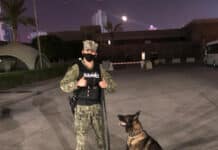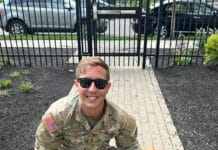 California University of Pennsylvania student Brittney Cassidy found that it was no easy task re-entering civilian life after leaving behind the camaraderie she experienced while deployed to wars in Iraq and Afghanistan with her Pennsylvania Army National Guard unit.
California University of Pennsylvania student Brittney Cassidy found that it was no easy task re-entering civilian life after leaving behind the camaraderie she experienced while deployed to wars in Iraq and Afghanistan with her Pennsylvania Army National Guard unit.
by Arnaldo Rodgers
“It doesn’t get hard until you come home,” said Cassidy, a Cal U senior who is studying communication disorders.
For some veterans, the challenges of returning home and finding a place again in the civilian world after what they have experienced are too much for them to handle. The U.S.
Department of Veteran Affairs estimates that 22 veterans commit suicide every day, equal to about one every 66 minutes and 8,000 a year, according to a 2012 report. That’s a slight increase from the estimated 20 suicides per day among veterans in 1999 and 2000, prior to the Sept. 11, 2011, terrorist attacks and the subsequent wars in Iraq and Afghanistan.
“Suicide is here, and it exists. It is on our campus, and it is in our local community,” Capt. Robert Prah, director of the Office of Veterans Affairs at Cal U, said at a recent campus program on preventing suicides among veterans and active duty military. Prah, a member of the Army National Guard, is a suicide intervention officer and a trainer for the Army-approved Ask, Care, Escort suicide prevention and awareness training program. Taking a toll
Suicide has claimed the lives of more veterans than all of those military personnel who died in the war in Afghanistan since 2001 and the war in Iraq since 2003, said Prah, an infantry company commander who was deployed with the 56th Stryker Brigade Combat Team in Iraq in 2008-09.
Among active duty service members, the Defense Department’s Suicide Event Report found there were 319 suicides in 2012, a rate of 22.7 per 100,000. There were 73 suicides two years ago in the Air Force, Army, Marine Corps and Navy reserves, a rate of 19.3 per 100,000, and 130 in the National Guard.
The highest rate of suicide — 28.1 per 100,000 — was among the Army and Air Force National Guard.
“That (suicide rate) is entirely too high,” Prah told an audience of about 20 people that included Army veterans, members of the National Guard, the Reserve Officer Training Corps, as well as Cal U faculty and staff.
Robert Milhoan of Washington, Pa., an Army veteran who served in Iraq in 2010-11, said he did not realize the suicide rate was as high as reported. Milhoan, a Cal U student studying archaeology, said the suicide prevention training is important.
The goal of a suicide intervention program, Prah said, is to get the person contemplating suicide into a “safe zone” where he is kept alive until emergency responders or health professionals can arrive.
RESOURCES AVAILABLE
“This is important for veterans to know there are resources out there. They are not alone,” said Cassidy, 26, a Johnstown area native.
The Army National Guard has responded to the rash of suicides by hiring additional behavioral health care staff at the state and top levels, promoted resilience training and worked with professionals to help understand the root causes of suicidal and high-risk behaviors, according to Maj. Gen. Judd H. Lyons, the acting director of the Army National Guard.
Among the typical warning signs of a person contemplating suicide are withdrawal from friends and not interacting with others, quitting classes and downplaying the significance of big issues while allowing small issues to become big, Prah said. In some instances, behavioral health issues play a factor in a suicide.
In some cases, there is a change of mood, a sense of “euphoria” because the person contemplating suicide has set and has an end plan, said Jason Brosk, a readjustment counseling therapist working with veterans at the Department of Veterans Affairs center in McKeesport.
Brosk said he has found that most veterans contemplating suicide have drug or alcohol problems, family problems or relationship problems.
Other times, a suicide attempt can be entirely impulsive and there are no warning signs, said Brosk, a combat veteran who led a reconnaissance platoon in Iraq in 2003.
“If you see someone that may need help with underlying issues, please refer them,” Prah said.
SAFE INTERVENTION
The audience was told they should not be afraid to intervene if they know a veteran is contemplating suicide.
“You need to have the ability to be able to talk about suicide,” said Capt. Carolyn Clements, assistant director and military coordinator for Cal U Global Online. Clements is a trainer for Applied Suicide Intervention Skills Training, the Army-approved intervention training for Army leaders, chaplains and other care providers.
“You have to ask the question: ‘Are you thinking about suicide?’” Prah said.
“If you are blunt, nine times out of 10 they will be truthful,” Brosk said. “If they are seriously considering suicide, call 911 or an ambulance.”
Prah cautioned anyone intervening with a person considering suicide must be aware of their own safety. Friends can’t agree to keep secret any information that someone in distress is considering suicide, Prah said.
“You just have to let someone know if someone is contemplating suicide,” Prah said.
All content herein is owned by author exclusively. Expressed opinions are NOT necessarily the views of VNR, authors, affiliates, advertisers, sponsors, partners, technicians, or VT Network. Some content may be satirical in nature.
All images within are full responsibility of the author and NOT VNR.
Read Full Policy Notice - Comment Policy





























